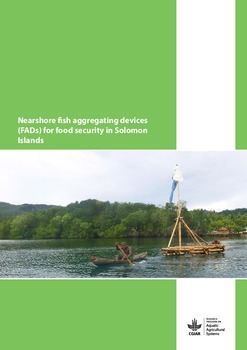Nearshore fish aggregating devices (FADs) for food security in Solomon Islands

Citation
Albert, J.A. et al. (2015). Nearshore fish aggregating devices (FADs) for food security in Solomon Islands. CGIAR Research Program on Aquatic Agricultural Systems. Penang, Malaysia. Program Brief: AAS-2015-05
Coastal fisheries are central to the lives of rural Solomon Island villages, supplying daily food and serving as one of the few sources of income. Yet, it is predicted that coastal fisheries in Solomon Islands, like many countries in the Pacific region, will not be able to provide enough fish to meet peoples' needs by 2030. Proposed strategies to prevent this scenario include improving the management of coastal fisheries and diversifying sources of fish by enhancing access to other fishes, either through aquaculture or the use of fish aggregating devices (FAD). Nearshore FADs (sometime referred to as inshore FADs) are FADs that are anchored to the seafloor, close to the coast to allow access for coastal communities, including by paddle canoe. As part of the Solomon Islands Ministry of Fisheries and Marine Resources (MFMR) strategic priority to improve the health of inshore fisheries and marine resources to support the nation's rural communities, the New Zealand-funded MSSIF (Mekem Strong Solomon Island Fisheries) programme provided funding to WorldFish to work in partnership with MFMR to "develop a Solomon Island National Inshore FAD Programme" (2010-2013). Through a larger collaboration between MFMR, Secretariat of the Pacific Community (SPC), University of Queensland (UQ) and WorldFish, twenty-one nearshore FADs, using four different FAD designs were deployed at various locations across Solomon Islands to assess FAD design and evaluate their contribution to food security. This program brief draws on data collected from four of the FAD locations.
Permalink
Date Available
Type
Publisher
Countries
Copyright
CC BY 4.0
Research Themes